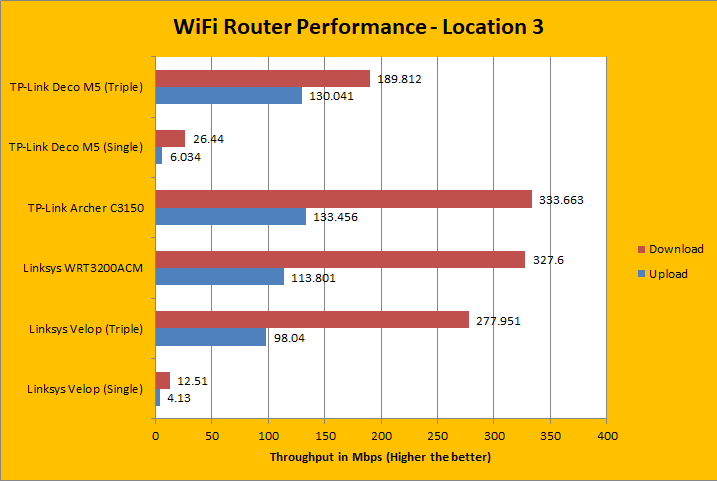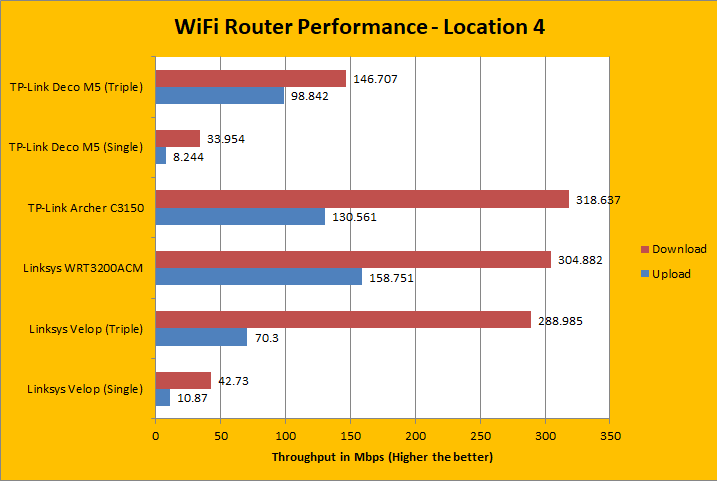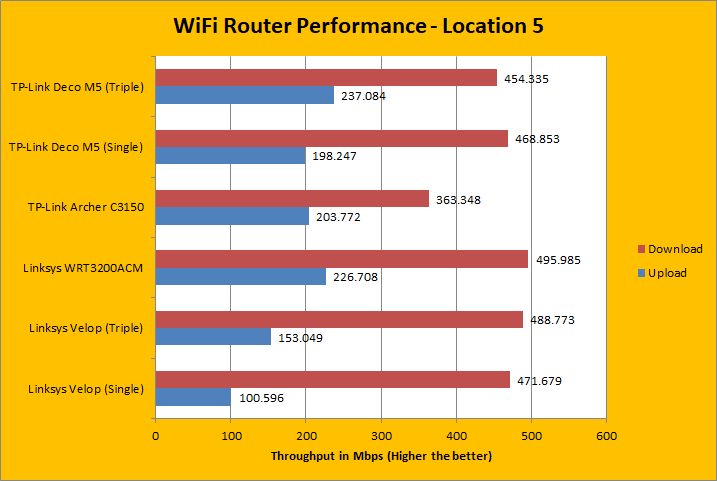Page 4 - Performance Tests

For the tests, the wireless router was placed in the middle of the main floor of Editor-in-Chief Jonathan Kwan's house. An ASUSTOR AS3202T network attached storage equipped with a single Seagate NAS HDD ST4000VN000 4TB was connected to the router via a CAT5e cable on a Gigabit Ethernet connection. On the client side, a 2015 13" Apple MacBook Pro running Totusoft's LAN Speed Test application was used to transfer 500MB test files to evaluate real-world throughput. In our results, "upload" is defined as data transfer from the client to the server via the wireless router; conversely, "download" is defined as data transfer from the server to the client via the wireless router. All of these tests were ran several times at each location to ensure accuracy.
A brief description of the test locations is as follows:
- Location 1: Line of sight to router, approximately 2m distance
- Location 2: Non-line of sight to router, bedroom, one floor up
- Location 3: Non-line of sight to router, driveway in front of attached garage, same level
- Location 4: Non-line of sight to router, near end of backyard, one floor down
- Location 5: Non-line of sight to router, open area, one floor down
Compared Hardware:
- TP-Link Deco M5 (AC1300 Mesh)
- Linksys Velop (AC2200 Mesh)
- Linksys WRT3200ACM (AC3200)
- TP-Link Archer C3150 (AC3150)





Since wireless channels are generally characterized by path loss, large scale fading, and small scale fading, the router was tested in five different locations described above to comprehensively measure its true throughput performance. This includes a combination of line of sight and non-light of sight spots, different distance and positions relative to the router, as well as shadowing caused by objects between the laptop and the router. In order to overcome inconsistencies due to small scale fading, a relatively large 500MB test file was used. Furthermore, movement of people and objects within the vicinity of the devices during testing was eliminated whenever possible. To test the Deco mesh system with all three nodes, one additional node was placed near Location 3 and one between Location 4 and 5 to strategically exploit the advantage of a mesh system. I should mention we did require an internet connection to the Deco M5 during our tests, as we were unable to create a local area network without it. This is possibly because the main node treats the only Ethernet connection it has as the connection to the modem. However, in our tests this was the NAS, which would affect how the mesh system sees the router. Once we did connect to the Internet, the mesh network saw the NAS as a storage device.
At Location 1, the TP-Link Deco M5 with a single node fell quite a bit behind the high-performance routers. This should not be a shock at all, considering the much lower rated AC1300 compared to the AC3150 or AC3200 for the Archer and WRT3200ACM, respectively. However, when we added a second and third node, the mesh system buffed up these numbers quite a bit more, especially in the upload department. It still does not match the Linksys Velop, but I would not expect it to with the lower speed ratings. In this line-of-sight test, we did notice there were much lower numbers when we placed the laptop on the same surface as the router versus above it but at the same distance. Moving to Location 2, the difference between a single and triple setup was quite staggering, with it even outperforming the Linksys WRT3200ACM in the triple mesh setup. At Location 3, you can see there was quite a bit of power attenuation through a thicker garage wall. With an additional node placed just on the inside wall from the garage, the performance was boosted quite a bit more. At Location 4, the extra mesh nodes definitely helped with both upload and download speeds, though it is still slower for downloads compared to the Linksys Velop, as well as both uploads and downloads on the Archer C3150. At our fifth location, the measured numbers between the triple and single setup were pretty similar, despite having the extra node within line of sight of our test computer. Connecting directly to the central node one floor below was not a lot different than connecting to an additional node located one floor below with one hop. Interestingly, the upload speeds were quite competitive with even our higher end routers, but the download speeds are a bit slower.
Based on our graphs, I have to say I am actually not disappointed with the TP-Link Deco M5. For sure, it is the slowest router overall compared to all of the other competition, but this should not be a surprise at all, considering the AC1300 rating. When we added two more nodes to the mesh network, we were able to see notable speed gains in four of the five locations, indicating the mesh system is working as it should. However, there are still some issues with the Deco M5, which are similar to the Linksys Velop. For one, despite its lower speed design, performance definitely took a hit when there was an increase in tested distance and extra walls. This indicates still a relatively weak antenna design. In addition, the drastic speed rating difference at Location 1 based on the orientation of the test computer indicates the antenna is very directional. Overall, the broadcast power is pretty good, especially with the decent download rates, but the antenna is not exactly the most sensitive to deal with reception.
Page Index
1. Introduction, Packaging, Specifications
2. Physical Look - Hardware
3. Configuration and User Interface
4. Performance Tests
5. Conclusion





